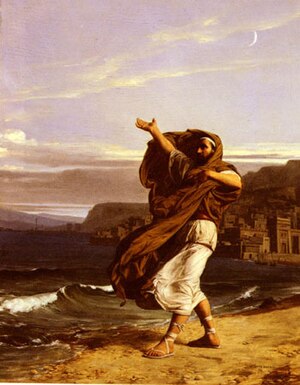Attic speakers
The ten Attic speakers are considered to be the greatest speakers and logographers of the classical era (5th – 4th centuries BC). They are contained in the Alexandrian Canon , which was compiled by the philologists Aristophanes of Byzantium and Aristarchus of Samothrace .
The speakers are listed in approximate chronological order in the list above. Her works inspired the later rhetorical movement of Atticism , with reservations about the antiphon and deinarchus, whose style later seemed too antiquated or was already criticized in antiquity.
Around 150 speeches have survived (some of them incomplete), many others have been lost. Some are considered "fake" and incorrectly bear the traditional author's name. The speeches are very unevenly distributed: the four authors Demosthenes (61), Lysias (32), Isocrates (21) and Isaios (12) together make up 85 percent, while the remaining 15 percent are divided between six authors. This is why the term “smaller Attic speakers” has become established in research.
The speeches were written over a period of a little more than 100 years, from around 440/430 (antiphon) to around 330/320 (Deinarchos and others), or from the "Periclean" age of Attic democracy to the Alexander period . That means differences in language and style as well as different historical, political and social framework conditions.
The Athenian citizens Aeschines, Andokides, Demosthenes, Hypereides, Isocrates and Lycurgus were able to appear as speakers in politics and in court. Deinarchus, Lysias and probably Isaios were immigrants without citizenship ( Metöken ) and as a rule could not do so; she and the Athenian antiphon worked as logographers , that is, as speechwriters for others.
Finally, the speeches are divided into several content categories: political speeches, court speeches and ceremonial or ceremonial speeches on special public occasions (including epitaphioi ), additional sample speeches for rhetoric lessons (e.g. the tetralogies of the antiphon of Rhamnus). The first three have been differentiated as speech genres since Aristotle (see Aristotle's rhetoric ).
The name of the “ten Attic speakers” therefore includes quite different authors and texts, and caution is required when making general statements about “the” ten speakers.
Web links
- Ancient source: Βίοι τῶν δέκα ῥητόρων - Vitae decem oratorum - Lives of the Ten Orators :
Pseudo- Plutarch : Lives of the Ten Orators. In: Plutarch's Lives and Writings, edited by AH Clough and William W. Goodwin, with an introduction by Ralph Waldo Emerson. London: Simpkin, Hamilton, Kent & Co., Ltd. [1914?], Vol. 5. Archived from the original on February 1, 2017 .
Individual evidence
- ^ Paul Kroh: Lexicon of Ancient Authors (= Kröner's pocket edition . Volume 366 ). Alfred Kröner Verlag, Stuttgart 1972, ISBN 3-520-36601-0 , p. 53 (Antiphon of Rhamnus) .
- ↑ Dinarchus, Hyperides, and Lycurgus . Translated by Ian Worthington, Craig R. Cooper & Edward M. Harris (= Michael Gagarin [Ed.]: The Oratory of Classical Greece . Volume 5 ). University of Texas Press, Austin 2001, ISBN 0-292-79142-9 , pp. 4 (English).
